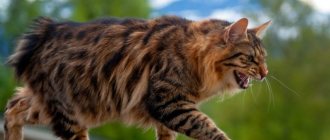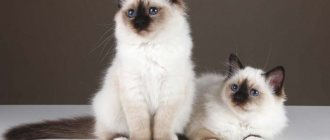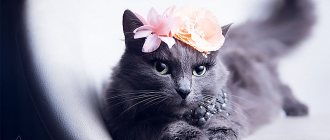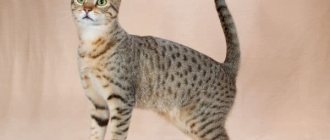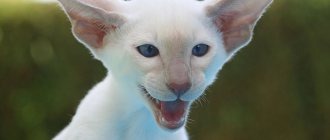Probably, the vast majority of the planet's inhabitants love cats. Fluffy, playful meowing creatures melted human hearts thousands of years ago and became full members of our families.
We make funny videos with them, take photographs for social networks, take care of them and love them immensely.
It would seem that all cats are created to be touched by them. But in fact, there are many cats that look menacing, have an aggressive character, and can even seriously harm a person. Introducing the 10 most evil cat breeds in the world .
Ural Rex
This breed first gained popularity in pre-war times. But after the war, the number of these cats decreased, and for a long time they were considered to have disappeared forever.
But in the 60s, it became known about Ural Rex breeders, and the myth about the disappearance of the breed was dispelled, although the breed is still considered quite rare.
People who buy a handsome Ural cat most often think about its unusual appearance, but do not think at all about the unpredictable nature of this cat.
Most often, such cats behave quite friendly and affectionately, but at any moment the cat’s behavior can change in a sharply negative direction . So owners and their guests should beware of sudden bites from their pet.
Egyptian Mau
The aggression of these cats is defensive. Egyptian Mau are very attached to their family, but are very wary of strangers. At the same time, most often they are shy and afraid more than they are angry.
But if someone encroaches on the things or “property” of the Egyptian beauty, then it would be better if he did not do this. The cat will hiss, growl and grab the hand of anyone who tries to touch its toy, bed or food.
Abyssinian cat
First of all, it is worth noting the unusual appearance of this cat.
Abyssinians do not look like domestic pets at all - from their color to the shape of their ears, they look like wild cats.
In character, this breed also resembles not affectionate domestic cats, but wild, dangerous predators . Moreover, Abyssinians treat their owners and other animals in the house quite friendly and affectionately.
But as soon as a stranger appears in the house, jealous surveillance begins. At any moment, the Abyssinian cat is ready to defend its territory and will gladly scratch your guest’s skin at any opportunity.
How to recognize aggression in a cat
It is quite easy to understand that a cat is currently not in the best mood if you analyze the external features of its behavior. A list of signs characteristic of a feline at the time of aggression is presented in the table below.
Table 1. Signs of an attack of aggression in a cat
| Part of the body | Sign |
| Wool | Stands on end. This condition is called piloerection |
| Pupils | Expanding |
| Sight | The cat's gaze is directed directly at the object of attack. At the moment of highest tension the animal stops blinking. In other situations, the pet may, on the contrary, look away |
| Ears | Pressed against the head |
| Pose | The back arches, and the animal itself crouches to the ground, emitting a characteristic rumbling sound. |
It is important to understand that you should never try to calm or rebuff an aggressive cat. The best way out of this situation is to give the pet the opportunity to be alone and recover. If an attack of aggression occurs very suddenly, it makes sense to wrap the animal in a blanket to block all possible external stimuli. Over time, the pet will calm down.
One effective way to calm a cat is to wrap your pet in a thick blanket.
Chausie
Aggressive jungle cats took part in the selection of this breed. Representatives of the reeds have never been distinguished by a calm character, and they passed this heritage on to their descendants Chausi.
“Wild” blood makes itself felt in the character of any cat of this breed . But the aggressive nature of these cats can be curbed with proper, strict education. You need to give your kitten enough attention from an early age, and then he will grow into a well-mannered pet.
But if the owner does not have time to communicate with his pet, then baby Chausie will grow into a naughty cat who is capable of doing completely unthinkable things. The owner can expect not only scratched hands, but also a house turned upside down.
Manul
Manul is one of those breeds that cannot be tamed . These cats are too freedom-loving and will never obey a person.
It is worth noting that the disobedience of the Pallas cat is primarily due to the fact that he is not a domestic cat, but a wild one. That is, these cats feel very comfortable living in natural conditions, but they are not adapted to living side by side with humans .
As soon as the manul senses danger, he will immediately attack the person. Its claws are considered very powerful by feline standards, and its fangs are 3 times longer than those of an ordinary cat. It is worth noting that Pallas cats not only behave aggressively, but also look quite menacing .
Snow Shu
A breed called Snow Shoe is not very widespread. This is due to their restlessness, which makes them want to hunt for something or someone, play pranks, and having received punishment, hide and take revenge on a harmful person. Cats - “snowflakes” are smart, can open locks and doors, manage, scatter and hide small change.
Owners say that when Snow Shu raises his voice, he can hit a loud person with his paw. So, think three times before getting such a pet.
Savannah
The luxurious spotted color and rather impressive size of the savannah bring to mind associations more with a reduced sevral than with an ordinary domestic cat.
This cat breed is distinguished by fairly high intelligence. They are smart, always loyal to their owner and easy to train.
The owner can raise an excellent friend and companion from a cat of this breed, but other people around will forever remain strangers to her . Therefore, she will want to attack guests at home or passers-by on a walk if she feels that they pose a danger to the savannah itself or to the owner.
British Shorthair
Short-haired graceful cats, which have become a real treasure of Great Britain, have always captivated people from all over the world with their unusual muzzle shape and incredibly beautiful coat.
By nature they are quite independent and calm. The British breed is one of the most popular in the world.
But the British are not at all good-natured . Most often, these cats are not attached even to their own owner and in every possible way show how important personal space is for them.
If he does not want a person to pick him up or stroke him, the cat will demonstrate his reluctance by scratching and biting him.
Cathesian
Not the most common, but one that ranks among the top evil cat breeds is the Chartreuse or Cathesian. Cats of French origin are extremely jealous, considering themselves the only ones they love. They cannot stand competition, they do not want strangers and are afraid of them, and for this reason they do not get along with other pets at all. Their capricious nature also requires space for maintenance; a private house is perfect.
Self-sufficiency, impatience with changes in daily routine and habitat, and reluctance to forced hugs make Chartreux not the most desirable family members. But if they really love the owner, they will show him their affection in every possible way and seek attention.
jungle cat
Jungle cats are still considered wild , despite the fact that more and more people are expressing a desire to have a representative of this breed at home.
People are most often captivated by the resemblance of this unusual cat to a lynx. The charming tufts on the ears and the massive size of the jungle cat certainly look beautiful.
But nevertheless the natural predatory habits of the breed make themselves felt, and experts generally advise against keeping a jungle cat at home because of its evil and unpredictable nature.
Attention! People who have small children living in the house should especially beware of purchasing this breed. It is no easier to tame a jungle cat than it is to tame a lynx or a cheetah.
Oriental
Oriental cats are next on the list of the most evil breeds. They are very capricious, selfish, deciding everything and always for the whole world. They are fast and energetic, they do not like being forced to be affectionate or being ignored. If you don't notice their ears, you risk getting a depressed cat in the house who will behave vindictively and disrespectfully, marking in slippers and making marks on wallpaper and furniture.
Maine Coon
Representatives of this breed delight people with their stern appearance and massive body. In size, they are almost twice the size of ordinary cats.
They are distinguished not only by their beautiful and unusual appearance, but also by their flexible mind and high intelligence.
Maine Coons by their nature are real phlegmatic people. They are quite calm and confident. However, if you raise a Maine Coon incorrectly, you can end up with frequent hissing and attempts by the cat to bite or scratch not only strangers, but also its own owner .
However, you should not think that aggressive individuals are common among Maine Coons. Rather, the aggression of this breed is the result of improper upbringing or lack of proper attention of the owner to the cat person.
Features of cohabitation
There is one good expression that you can tame a tiger with love. And it is confirmed by the experience of many animal lovers. There have been cases where animal rescue workers have had to remove wild, frightened, hungry or injured animals from the streets. A few hours of affection (if the animal itself wants it), and the animals became kind, because they understood that these people would not harm them.
Affection will help cope with cat anger
With a pet, everything is much simpler - you know and love him, so it will not be so difficult for you to find an approach to the animal. The main thing is patience and affection. If an animal is evil, then under no circumstances should you try to change it using pressure. It must see that you love it, then the beast’s attitude towards you will be corresponding.
Of course, it is difficult to ensure that a cat begins to treat strangers, like you, favorably. But you will be comfortable living together peacefully. Pet your pet and talk to it more often - at these moments show and tell how to behave.
Important! It is not recommended to punish animals - it will not lead to anything good and will only alienate you.
Here are some more tips for dealing with angry pets:
- From the first days of your cat's stay in the house, start training it. If from an early age a cat is prone to playing with the hands and feet of its owners, then stop attempts to bite or scratch immediately;
- if there are children in the house, then tell them that the animal suffers when it is “squeezed”;
- Explain to guests who are unfamiliar with the pet that there is no need to pick up the animal, as it may bite or scratch;
- pet and pick up your pet only after his permission;
- When a new pet appears in the house, do not forget about your other pet.
Some wild cat breeds are practically untameable. For example, a jungle cat. Keeping such an animal at home is dangerous - it can behave unpredictably and aggressively. The height of the animal is 60–90 cm, while it is quite thin and because of this weighs no more than 12 kg. The color of the cat is red-gray.
Siamese cat
Siamese cats are considered one of the most beautiful in the world. This breed is very popular not only because of its beautiful appearance, but also because of its high intelligence.
These cats are very smart and easy to train. They are easy to train and even loyal to humans. But in addition to high intelligence, these cats also received phenomenal memory.
Once an owner offends a Siamese cat at least once, he will remember it forever . And not only will he remember, but he will also want to take revenge at the moment when the enemy is unarmed.
There are many examples of Siamese cats attacking their owners while the latter were sleeping in bed. Therefore, you should not offend Siamese cats or treat them unfairly.
Predatory cats
Scientists have long confirmed that all modern cats descended from 5-10 species of evil wild animals. Breeders continue to crossbreed different breeds in hopes of creating the perfect wild-looking cat. Most often, such efforts end in a genetic fiasco or natural anger takes over.
Then the seemingly harmless animal becomes a serious threat to others. To understand the danger of such connections, it is necessary to understand which of the wild ancestors represent the parental line of the pet.
A large predatory animal in a brown-gray color, with tufts on the ears and the character of a hunter. Males grow up to 90 cm. Such a pet can be kept in the house, especially if upbringing begins in childhood.
Evil jungle cats always guard their territory, according to the centuries-old instinct of dividing into zones of influence with other animals. Therefore, all the talk about neutral relationships with pets looks very unconvincing.
At the first opportunity, the evil jungle cat will establish its own order and drive away all strangers from the territory.
It is not recommended to keep a jungle cat indoors. This evil breed is best suited to an equipped spacious enclosure, where all conditions for a comfortable life will be created.
Wild manul
A predatory and very angry cat with short legs and a dense, massive body. It is half the size of its reed predecessor and weighs about 5 kg. The breed is notable for its thick and fluffy coat - up to 9 thousand hairs grow per 1 cm2. But such a miniature (by natural standards) build and harmless appearance should not be misleading.
The aggressiveness of this cat is at the highest level of danger, and its ability to track down prey and silently attack it leaves practically no chance of a successful outcome. The Pallas's cat does not hunt humans, because it understands the difference in size, but it is not accustomed to retreat either. If such a cat gets angry and attacks the offender, then it will not be possible to get away with a slight fright.
Even as a kitten, this breed exhibits anger. Therefore, you will have to make a lot of effort to convince the Pallas's cat of the need to humble his proud disposition.
No one has yet been able to completely tame a cave cat; it cannot tolerate hygiene procedures, and will not stop hunting under any conditions. An exotic wild pet can only be kept in an enclosure.
All domestic cats have the same reasons for their anger. In the first place are breed qualities. Bengals, British, Siamese cats have an innate tendency towards aggression. It manifests itself differently in everyone, but the predisposition is fixed by genetic development.
The second reason is improper upbringing. Any cat can become evil, even if it belongs to the order of decorative tigers or harmless ragamuffins.
Third – living conditions and stress. Loud sounds, unusual smells, lack of attention from the owner - the cat evaluates all the circumstances and reacts to them. The cat’s mood also changes during the mating period.
Bengal cat
It is no secret that Bengal cats were bred by crossing domestic cats and wild ones. Therefore, in the character of this breed, the temperament of a gentle domestic cat and the burrows of a real wild, unbridled predator are intricately crossed with each other.
In normal circumstances, Bengals are quite calm and serene animals, whose behavior is no different from other domestic cats. However, if it seems to them that there is danger somewhere nearby, the hunting instinct takes over. Therefore, Bengal cats can seriously harm humans .
It is also worth noting that this breed is practically not trainable .
What cat breeds are recognized as the most evil?
We will not consider completely wild cats, such as the jungle cat, lynx, caracal and manul. These pets should be owned only at your own risk.
This article will present breeds recognized by international felinological organizations. They are all adapted to live with humans, but due to their characteristics they require a little more understanding and care.
Savannah
Savannah is a hybrid. It was obtained by crossing a wild serval with a bengal. Due to the presence of wild blood, the savannah has an independent and capricious character. Most often she shows aggression towards strangers.
Breeders recommend purchasing Savannahs from at least the second generation, that is, F2. Their genes contain only 25% of the serval, so they are much better at contact with humans.
All subsequent generations are even more similar to a domestic cat, but with the development of a softer disposition, their appearance significantly suffers. Minimal similarity to the Serval is typical for the F4 and F5 generations.
Despite their shortcomings, Savannahs are notable for their canine devotion. They constantly need communication and get along well with kids due to their playfulness.
Bengal
An elite breed, famous for its gracefulness and resemblance to a leopard. Obtained by crossing an ordinary domestic cat with a wild Far Eastern cat from Thailand. Uncontrollable character traits appear only in the first 3 generations of hybrids, so feel free to take a pet from the F4-F7 category.
Bengals are clean, easy to train and love active games. They are very social and easily get along even with dogs. Their disadvantages include a developed hunting instinct and the unacceptability of violent hugs. For this reason, it is better not to leave Bengals with small children and potential prey (fish, rodents, birds).
Chausie
The closest relatives of the Chausie are jungle cats, that is, this is another hybrid with wild cats. The most obstinate character is observed in the first 2 generations: F1 and F2. Everyone else is more flexible and calm.
Chausies love to make hiding places, are prone to “rock climbing” and love to swim. They become strongly attached to their owners, support children's fun with great enthusiasm and are not at all against the company of other four-legged animals.
Despite their loyal and friendly nature, the Chausie cannot be considered a patient breed. For twirling a mustache and stroking against the grain, they will definitely punish their offender.
It is equally important to remember about the developed hunting instinct. Keeping chausies together with hamsters and parrots can end very badly.
Maine Coon
Maine Coons are aboriginal cats with a pronounced territorial instinct. This is where their danger lies. They also do not tolerate familiarity. When meeting a stranger, Maine Coons try to keep their distance, assessing the danger of a potential enemy. If you don’t stoop to squeezing and forcibly picking her up, then over time the anger will definitely change to mercy.
Due to their gigantic size, Maine Coons often make a mess and can even cause serious injury to humans. They do both not out of malice, but banal caution is required from the owner.
Maine Coons are most active at night, so it is best to keep them in a spacious home. Otherwise, you will hardly be able to sleep, because it is almost impossible to barricade yourself in a small apartment.
Mekong Bobtail
Mekong Bobtails are ideal pets for families with children. They get along well with kids, love communication and are not at all opposed to tactile contact. Many pets take great pleasure in falling asleep with their owners in the same bed and constantly following them with their tails.
Because of their canine devotion, bobtails can be unusually jealous. They are also wary of strangers. We must not forget about the developed hunting instinct. For small pets, Mekong Bobtails pose an increased danger.
These cats become strongly attached to their household members and cannot stand being alone for long periods of time. They divide people into “us” and “strangers”, so at first they are hostile to their masters’ new passions. Over time, anger gives way to mercy, but at first it is better for a stranger to be careful and keep his distance.
Siberian
Despite all their friendliness, “Siberians” from birth do not trust strangers and cannot tolerate familiar treatment. Thanks to their playfulness, they are not against playing together with children, but they can also fight back without hesitation for a sloppy or downright painful touch.
“Siberians” are not intrusive and have great respect for those who observe a similar sense of tact. If the cat does not respond to your affection, leave him alone and wait for a more opportune moment.
British
“The British” are the true embodiment of calm and serenity. First of all, they are suitable for workaholics, as they do not mind daily absences at all.
Despite their unobtrusiveness, the “British” love affection, but with certain reservations. Most often, only one owner becomes their favorite, but even to him they are reluctant to kneel. For this reason, it is better to avoid too close contact in the form of hugs, limiting yourself to simple stroking.
Also, the “British” get along well with calm and slightly phlegmatic children who respect the independence of those around them. The peak of activity in these cats is observed in childhood and adolescence, but even mature pets sometimes run around the apartment in pursuit of a thrown ball.
Abyssinian
“Abyssinians” are very afraid of loud and sharp sounds. Because of this, they do not get along well with constantly crying babies and hyperactive older children. Despite this, the “Abyssinians” show patience to the last and only release their claws when they are truly disrespectful.
These cats closely resemble dogs. They quickly learn to fetch objects and need constant contact with humans. Without regular attention, they fall into deep depression and fall ill.
Siamese
The Siamese are known for their vindictive cunning. Thanks to their excellent memory and innate ingenuity, they often attack on the sly when the culprit has completely forgotten what he did. For this reason, when raising Siamese, you should not abuse punishments and use them only if there is a good reason.
Animals get along with children with varying degrees of success. The thing is that they are completely devoid of patience. Any mistake on the part of the little owner is immediately punished with a clawed paw. For children under 6-7 years old, it is better to choose someone friendlier.
Siamese have a negative attitude towards loneliness, because they are recognized as the most talkative cats. Also, these pets are very sensitive to human emotions. Frequent communication in a raised voice can make them withdrawn, cowardly and embittered.
Ocicat
Despite the strong resemblance to the ocelot, the Ocicat's closest relatives are the Abyssinians, Siamese and American Shorthairs. For this reason, they do not have pronounced wild instincts inherent in hybrids. But the parental traits are fully inherited:
- Siamese talkativeness, but without excessive talkativeness;
- Abyssinian contact.
Ocicats differ from the mentioned breeds only in that they are not at all afraid of strangers. They quickly find a common language with them and can even jump into their arms when they first meet them. Animals show complete indifference only to those who allow themselves too much or do not show reciprocal cordiality.
Ocicat aggression is usually only shown towards other pets and human feet. Both occur due to the developed hunting instinct. They can also be very jealous if the owner pays much more attention to another two-legged or four-legged household member.
